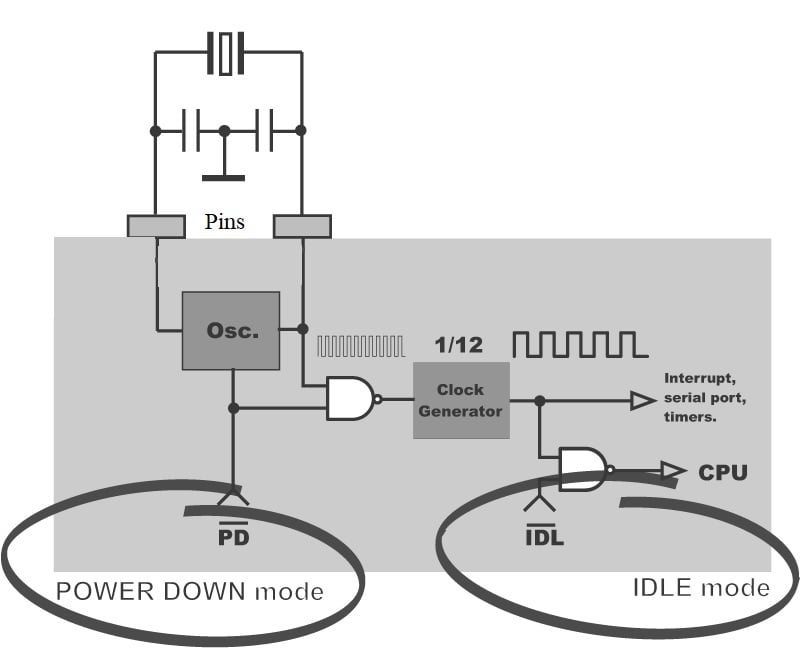Table of Contents
Toggle- Power Saving mode in 8051 microcontroller is used to save energy during idle time of processor and during power down time of processor. So, is important to make microcontroller as a power saving device.
- The 8051 uses current of approximately 25 mA during the normal operation.
- In power saving mode, the 8051 microcontroller reduces its total consumption to approximately 40μ
- The 8051 supports two power-saving modes of operation: Idle and Power Down as shown in Figure.

Idle Mode
- After setting the bit IDL in the PCON register, the microcontroller turns into idle power saving mode.
- Where serial port, timers and interrupt system continue operating normally consuming 6.5 mA.
- In Idle mode, the content of all registers and I/O ports is remains unchanged i.e. the CPU status is preserved entirely.
- SP, PC, PSW, Accumulator and other registers remains as it is their data during IDLE mode.
- In order to operate the microcontroller normally, interrupt or reset signal can be used.
- Then the IDL bit is automatically cleared and the continues execution from program instruction following that instruction which has set the IDL bit.
Power Down Mode
- After setting the bit PD in the PCON register, the microcontroller turns into idle power saving mode.
- In this mode, 8051 turns off its internal oscillator which reduces power consumption.
- In power-down mode, the 8051 microcontroller operates using only 2V power supply where the total power consumption is less than 40 μA.
- The microcontroller can be brought to normal mode by using hardware reset signal only.
- In Power Down mode, the contents of all SFR registers and I/O ports remains as it is.
- But after the microcontroller brought into the normal mode, the content of the SFR register is lost, but the content of internal RAM is saved.
- Reset signal must of approximately 10 ms so that 8051 microcontroller can stabilize quartz Oscillator operating.
- In the Power Down mode, the oscillator is completely stopped, and the instruction that invokes Power Down is the last instruction executed by 8051 microcontroller.
- The internal RAM and Special Function Registers save their values till the Power Down mode is removed.
Difference Between Power Down Mode and Idle Mode in 8051
Sr. No. | Power Down Mode | Idle Mode |
1. | Power down mode is set by setting the PD bit of the PCON register. | Idle mode is set by setting the IDL bit of the PCON register. |
2. | In the power down mode, the on-chip oscillator is stopped. | In the Idle mode, the internal clock signal is gated off to the CPU, but not to the Interrupt, Timer, and serial Port functions. |
3. | With the clock frozen, all functions stopped but the state of all SFR registers, contents on-chip RAM and I/O ports remains unchanged. | The CPU status is preserved, the Stack Pointer, Program Counter, Program Status Word, Accumulator and all other registers maintain their data during Idle. |
4. | Hardware reset required to terminate power down mode. | To terminate Idle mode, execute any interrupt or reset which will clear IDL bit automatically. |
5. | Operate using only 2V power supply while a total power consumption is less than 40μA. | Microcontroller turns off CPU unit while peripheral units such as serial port, timers and interrupt system continue operating normally consuming 6.5mA.
|
PCON register

The purpose of the Register PCON bits is:
- SMOD Baud rate is twice as much higher by setting this bit.
- GF1 General-purpose bit (available for use).
- GF1 General-purpose bit (available for use).
- GF0 General-purpose bit (available for use).
- PD By setting this bit the microcontroller enters the Power Down
- IDL By setting this bit the microcontroller enters the Idle
Recent posts
Related posts:
- Assembler Directives in 8051 Microcontroller
- Features of 8051 Microcontroller
- Memory Organization of 8051 Microcontroller
- Addressing Modes in 8051 Microcontroller
- Instruction Set in 8051 Microcontroller
- Architecture of 8051 Microcontroller
- PSW Register in 8051 Microcontroller | Program Status Word
- Pin Configuration of 8051 Microcontroller
- The Stack and Stack Pointer in 8051 Microcontroller
- Stack Pointer Data Pointer and Program Counter in 8051 Microcontroller
- Functions of Timing and Control Unit of 8051
- Functions of Ports in 8051 Microcontroller
- Port Structure of 8051 Microcontroller
- Reset Circuit of 8051 Microcontroller
- Registers in 8051 Microcontroller
- Boolean Processor in 8051 Microcontroller


